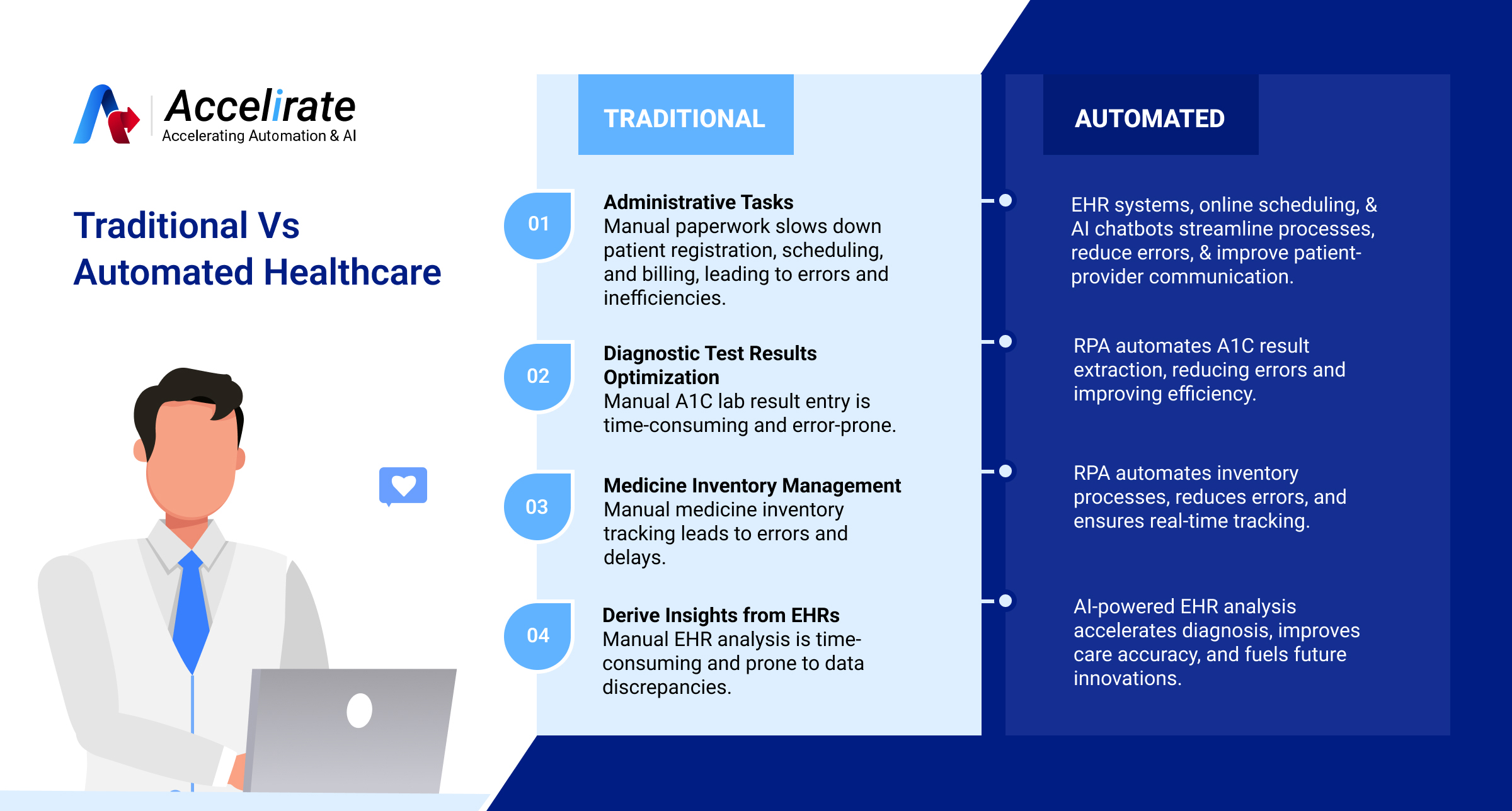Automation Healthcare
BLOG
8 min read
How to Improve Process Efficiency in Healthcare with Automation
The World Health Organization (WHO) forecasts an expected shortage of 10 million healthcare workers by 2030, primarily concentrated in low- and lower-middle-income countries.
Automation has become an integral part of modern life, impacting a wide range of industries, including healthcare. In the ever-evolving world of medicine, healthcare providers are constantly seeking ways to improve patient care, reduce costs, and enhance overall efficiency. One way they are achieving these goals is through the implementation of automation in various aspects of healthcare processes. This article delves into the transformative impact of automation on healthcare efficiency through a comparative study of traditional and automated processes.
The Rise of Automation in Healthcare
Automation in healthcare refers to the use of technology and digital systems to streamline various processes, ranging from administrative tasks to clinical procedures. The integration of automation in healthcare has grown significantly in recent years, and this trend is expected to continue as the healthcare industry seeks innovative solutions to meet the increasing demands for quality care and cost-effective services.
The worldwide artificial intelligence market achieved a valuation of $10.4 billion in 2021 and is anticipated to grow at a compound annual growth rate (CAGR) of 38% from 2022 to 2030.
Comparing Traditional and Automated Healthcare Processes

1. Administrative Tasks:
Traditional: In a traditional healthcare setting, administrative tasks such as patient registration, appointment scheduling, and billing are often paper-based and time-consuming. These processes can be prone to errors, leading to inefficiencies.
Automated: Automation in healthcare streamlines administrative tasks by utilizing electronic health records (EHR) systems, online appointment scheduling, and automated billing software. This results in a notable reduction in errors and time savings for both patients and healthcare providers. The quality of communication between patients and doctors has improved with the implementation of automation. The introduction of chatbots has simplified the process of addressing patient queries, making appointment scheduling more efficient. AI, employing natural language processing (NLP), facilitates the conduct of surveys and the analysis of responses, leading to a significant enhancement in the quality of follow-up care.
How has automation improved your experience as a patient or healthcare provider?
Tell Us!2. Diagnostic Test Results Optimization:
Traditional: Patients with Diabetes require regular blood tests, with the pivotal A1C test serving as a crucial diagnostic tool for identifying prediabetes and diabetes. However, conventional documentation lacks specific values, leading to increased time demands on doctors. The current manual process involves Medical Assistants inputting data from scanned papers into the system, including the Date of the Study and corresponding values. This method is time-consuming, relies on human input, and is prone to errors.
Automated: To address the challenges of the traditional approach, an automated solution is proposed. Scanned Lab Records/Documents serve as input, and the Scanning Engine acts as the trigger, identifying A1C lab results. Utilizing RPA Document Understanding, the system utilizing RPA Document Understanding oversees the A1C Documents Folder to detect Lab Result PDFs. Once the presence of an "A1C" value is confirmed within the PDF, the RPA bot extracts the value, enters the data into the system to generate a new encounter, uploads the PDF, and stores the A1C Result. The output is a discrete entry of the lab value into the system, eliminating the need for patients to undergo redundant tests and enhancing the efficiency of patient care services.
3. Medicine Inventory Management:
Traditional: In traditional medicine inventory management, the process often involves manual tracking, ordering, and restocking of pharmaceutical supplies, which can be time-consuming and prone to errors. Healthcare facilities may face challenges such as stockouts, overstocking, and difficulties in maintaining an accurate record of expiration dates. Thes processes are also relevant to audit and compliance for programs such as 340B.
Automated: RPA streamlines inventory operations by automating tasks such as order processing, tracking stock levels, and updating databases in real-time. This expedites the inventory management process and significantly reduces the likelihood of human errors. The automated approach ensures precise control over stock levels, minimizes the risk of shortages or excess stock, and enhances overall efficiency in pharmaceutical supply chains. By leveraging RPA, healthcare institutions can optimize their inventory management practices, ensuring the availability of essential medicines, reducing costs, and ultimately improving patient care.
4. Derive Insights from Electronic Health Records (EHRS):
Traditional: Analyzing patient data and medical records manually is time-consuming and can lead to data discrepancies and inefficiencies in clinical decision-making.
Automated: Imagine getting the right diagnosis faster! AI-powered EHR analysis pinpoints hidden patterns in your medical data, leading to quicker, more accurate care. Data sharing also ensures seamless collaboration between your doctors, improving your treatment experience. Plus, your data becomes fuel for the future, helping develop new technologies and treatments that benefit everyone.
5. Scheduling and Patient Billing Management:
Traditional: Manual scheduling is a labor-intensive process, particularly challenging in sizable and bustling healthcare establishments due to numerous variables.
Automated: RPA assumes control over all administrative responsibilities in a healthcare facility, executing tasks tirelessly and without boredom. Beyond overseeing billing and claims, including the management of scheduling, reminders, cancellations, and patient intake, automation contributes to streamlined processes and enhanced billing and revenue cycles. This results in a smoother patient management experience, allowing administrative staff to concentrate solely on tasks demanding leadership skills and decision-making.
How has automation improved scheduling and billing processes in your healthcare facility?
Let’s DiscussBenefits of Automation in Healthcare
Let’s look at some of the key benefits of automation in healthcare.
- Data Retrieval and Extraction: Many hospitals are implementing automation for the transfer and access of patient data. These tools swiftly input patient data across data stores, enabling seamless sharing across different divisions and locations. This capability is particularly crucial in the healthcare industry, where information sharing has been a significant challenge. In situations where a patient's assessment or care involves multiple departments, data transfers could lead to delays in the treatment process. Interconnecting every device within a facility to the same network allows information from one device to be accessed by another, reducing administrative costs and saving time.
- Streamlined Requesting: The process of requesting or ordering is often hindered by various obstacles and time constraints, typically requiring repeated and numerous clicks to initiate even a single request. AI, leveraging forecasting, can automate the placement of requests, thereby enhancing productivity and significantly saving time.
- Enhancing Patient Care Excellence: Automation empowers healthcare providers to deliver more thorough and personalized care. With the patient's profile readily accessible, efficiency is heightened, enabling seamless patient care. This technology aids healthcare providers in promptly detecting any deviations from the prescribed plan, expediting the billing process, and sending reminders to patients for follow-up consultations. Nowadays, numerous online applications and websites facilitate the booking of consultations, reviewing past ailments, and checking patient profiles.
- Cost Savings: By reducing errors, improving efficiency, and optimizing resource allocation, healthcare organizations can achieve cost savings in the long run.
Challenges of Automation in Healthcare
Here are some of the potential roadblocks that you might stumble upon in this transition journey. But don’t worry! Because the benefits definitely beat these challenges.
1. Initial Costs:
Implementing automated systems in healthcare can be expensive, which may deter some healthcare providers from adopting these technologies.
2. Enhance patient data coherence through technology:
Employ automation as a robust method to collate and corelate data across disparate systems. Automating case management limits access to a patient's health information as well as ensuring timely transfer of data across various billing and care management systems.
74% anticipate a deficit in the number of nurses, while 88% foresee a shortage of doctors.
3. Ensure seamless data visibility:
Utilize healthcare dashboards for effortless data visibility. Automated tools facilitate the collection of various data types, allowing administrators to assess operational efficiencies. Clinical data, resource availability, and allocation, as well as claims data, can be easily monitored. Dashboards prove beneficial for both healthcare providers and insurers.
4. Resistance to Change:
Healthcare professionals may resist automation due to concerns about job security and the need to adapt to new technologies.
How do healthcare dashboards contribute to improved data visibility and operational efficiencies in your organization?
Talk to the ExpertReady to Shape the Future of Healthcare Automation?
Automation has a transformative impact on healthcare process efficiency, offering numerous benefits in terms of accuracy, efficiency, and cost savings. While there are challenges associated with the initial cost and concerns about data security, the long-term advantages of automation in healthcare are difficult to ignore. As technology continues to advance, the integration of automation in healthcare processes will likely become more widespread, ultimately improving patient care and the overall quality of the healthcare industry.
56% of clinicians worldwide anticipate relying on tools employing artificial intelligence for the majority of their clinical decisions.
Explore how Accelirate's automation solutions can revolutionize efficiency in your healthcare organization. Contact us today for a personalized consultation.


